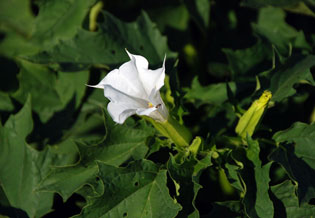JIMSONWEED
|
 |
| File Size: 57 KB |
|
|
|
Datura stramonium L.
|
| Konza Prairie, Riley County, Kansas |
| Annual |
| Height: 12-48 inches |
| Family: Solanaceae - Nightshade Family |
| Flowering Period: July, August, September |
|
| Also Called: | | Thornapple, moonflower. | | Stems: | | Erect, stout, often widely branched, coarse, green to purplish, glabrous to sometimes minutely pubescent. | | Leaves: | | Alternate, simple, dark green, strong-scented; blades inclined down, ovate to lance-ovate, 2 to 10 inches long, 1 to 8 inches wide, largely glabrous; margins coarsely and irregularly toothed; stalk .8 to 3.6 inches long. | | Inflorescences: | | Solitary flowers in leaf axils; short-stalked. | | Flowers: | | Showy, erect; calyx tubular, 1.4 to 2 inches long, narrowly 5-winged, unequally 5-toothed; teeth tapering to points; corolla funnel-shaped, 2.4 to 5+ inches long, white to occasionally purplish; top 1.2 to 2 inches across, 5-lobed; each lobe with slender tooth 1/8 to 1/3 inch long; stamens 5, 2 to 3.6 inches long, not extending out of corolla; anthers white in white flowers, purple in purple flowers. | | Fruits: | | Capsule, erect, egg-shaped, 1.4 to 2 inches tall, about 1 inch wide; base collar-like; usually covered with many short spines; spines slender, round, mostly 1/8 to 1/3 inch long, lower spines often shorter than upper; seeds many, kidney-shaped, 1/8 to 1/6 inch long, black to dark-brown, flat, surface pitted and wrinkled; capsule splits into 4 valves, releasing seeds. | | Habitat: | | Waste ground, old feedlots, barnyards, hog lots, flood plains, along streams, cultivated fields, pastures; dry, rich soils. | | Distribution: | | All but northwest 1/5 | | Origin: | | Introduced. There is debate whether jimsonweed is native to Asia or tropical America. | | Reproduction: | | By seeds | | Toxicity: | | Highly toxic. Contains potentially fatal tropane alkaloids. It is more a risk for humans than livestock. Unpalatable for livestock and only consumed when other forage is unavailable. However, can pose a risk in hay because it remains toxic after drying. Children have been poisoned by eating the seeds or drinking the flower nectar. The seeds are poisonous to poultry and songbirds. Symptoms of poisoning in humans and livestock include restlessness, irritability, depression, dilated pupils, delirium, impaired vision, constipation, fever, extreme thirst, and convulsions. | | Uses: | | Native Americans applied the crushed leaves to fresh wounds; boiled the leaves and applied the preparation for inflammation and fevers; smoked the plant to relieve asthma symptoms; rubbed a compound poultice of seeds on sore throats; and mixed the crushed seeds with tallow to treat hemorrhoids. The Aztecs used the seeds to induce hallucinogenic visions during rituals. The plant has been used to extract heavy metals from contaminated soils. | | Comments: | | The flowers open in late afternoon and have a sweet odor. Jimsonweed is pollinated primarily by night-flying hawk moths, but is also visited by hummingbirds and bees. "Jimsonweed" is a corruption of "Jamestown-weed", an original common name. In 1676, soldiers at Jamestown accidentally consumed Datura leaves in a salad and became incapacitated for several days. |
|
| Jimsonweed flowers |  | | 57 KB | | Konza Prairie, Riley County, Kansas |
| | Jimsonweed flower |  | | 41 KB | | Konza Prairie, Riley County, Kansas |
| | Jimsonweed leaves |  | | 147 KB | | Konza Prairie, Riley County, Kansas |
| | Jimsonweed leaf |  | | 98 KB | | Konza Prairie, Riley County, Kansas |
| | Jimsonweed fruit |  | | 66 KB | | Konza Prairie, Riley County, Kansas |
| | Jimsonweed fruit |  | | 66 KB | | Konza Prairie, Riley County, Kansas |
| | Jimsonweed calyx |  | | 41 KB | | Konza Prairie, Riley County, Kansas |
| | Jimsonweed |  | | 90 KB | | Konza Prairie, Riley County, Kansas |
| | |
|
|
|
|
|
|